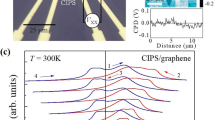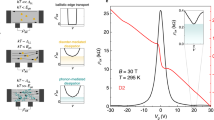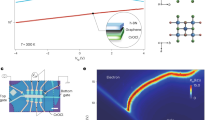Abstract
We have observed the well-kown quantum Hall effect (QHE) in epitaxial graphene grown on silicon carbide (SiC) by using, for the first time, only commercial NdFeB permanent magnets at low temperature. The relatively large and homogeneous magnetic field generated by the magnets, together with the high quality of the epitaxial graphene films, enables the formation of well-developed quantum Hall states at Landau level filling factors v = ±2, commonly observed with superconducting electro-magnets. Furthermore, the chirality of the QHE edge channels can be changed by a top gate. These results demonstrate that basic QHE physics are experimentally accessible in graphene for a fraction of the price of conventional setups using superconducting magnets, which greatly increases the potential of the QHE in graphene for research and applications.
Similar content being viewed by others
Introduction
Experimentally demonstrated for the first time in 19801, the quantum Hall effect (QHE) is one of the most striking phenomena in condensed matter physics. It arises when a two-dimensional electron gas (2DEG) is immersed in a strong perpendicular magnetic field. In the quantum Hall state, the bulk of the 2DEG is insulating and the current flows in ballistic and chiral one-dimensional channels along the edges of the samples2.
This very peculiar state of matter has been the object of an extremely vast corpus of fundamental research on various materials. Indeed, quantum Hall systems host a great variety of unique states and phenomena, such as fractal quantum Hall states3,4,5,6. Furthermore, the ballistic edge channels of the QHE make it possible to engineer devices implementing textbook concepts of mesoscopic quantum transport, such as the electronic Mach-Zehnder interferometer7. When coupled to a superconductor, QHE edge channels have recently been predicted to host propagating Majorana Fermions8. The QHE is currently used in metrology to define a practical resistance standard9, and the non-dissipative nature of the QHE edge channels is extremely attractive for applications in low-power and high speed electronics.
Experimentally, the QHE is obtained in materials such as gallium arsenide heterostructures, under a strong magnetic field (of at least a few Tesla) and at low temperatures. These constraints, which require the use of cryogenic refrigerators containing superconducting magnets to generate the magnetic field, stem from the small energy gap between Landau levels at low magnetic fields10.
Graphene can circumvent those constraints because, owing to its unique band structure, the energy gap is more than one order of magnitude larger than in gallium arsenide heterostructures at typical magnetic fields of a few Tesla.
Indeed, shortly after the first experimental observation of the QHE in graphene11, it has been demonstrated that graphene shows signatures of the QHE at room temperature when subjected to very large magnetic fields12.
The ability to tune the density of carriers, and even their type, in graphene by the field effect implies that the constraint of high magnetic fields could also be lifted for clean enough samples, in which carrier densities lower than 5 × 1010 cm−2 can be attained, making the QHE at the Landau level filling factor v = 2 reachable for magnetic fields lower than 1 T13,14. Such fields are then compatible with superconducting materials such as niobium, enabling the coexistence of superconductivity and QHE edge channels15,16. Furthermore, magnetic fields of up to 1 T can now be easily reached using inexpensive rare earth permanent magnets, such as neodymium (NdFeB) magnets made of Nd2Fe14B alloy, which have remanence fields of up to 1.4 T. Replacing the expensive, cumbersome and fragile superconducting solenoid magnets with affordable permanent ones would considerably expand efforts to probe and exploit the properties of the QHE.
In this paper, we show that the QHE can be induced in a graphene sample using NdFeB permanent magnets instead of the usual superconducting magnets.
Several fabrication techniques yield clean enough graphene samples so as to reach the QHE at sub-tesla magnetic fields. While boron nitride-encapsulated graphene17 provides the highest mobilities and is particularly well suited for fundamental research, epitaxial graphene18, grown either by thermal decomposition or by chemical vapor deposition on (6H-SiC(001)) silicon carbide (SiC) combines relatively high mobility, a very large single-crystal area, and high reproducibility, making it an excellent candidate for both research and applications. The QHE in epitaxial graphene has been extensively studied since its first observation19, particularly the extremely robust filling factor v = 2 QHE plateau with respect to both gate voltage and magnetic field20,21,22,23. This unique robustness makes epitaxial graphene a very appealing candidate for the realization of a practical resistance standard for metrology24,25,26. While all the aforementioned experiments were performed with superconducting magnets, we have used an epitaxial graphene sample installed in a custom-built sample holder, detailed below, to observe the QHE using only permanent magnets.
Results
Figure 1(A) is a schematic illustration of the sample holder. The holder is equipped with a commercial ceramic leadless chip carrier (LCC) socket through which a hole was bored so as to fit a cylindrical NdFeB permanent magnet (length ≈1 cm, diameter ≈6 mm) under the LCC. To generate an homogeneous magnetic field in a Helmholtz configuration, two additional magnets are aligned above the sample, separated from it by a ≈1 mm-thick spacer. As a result, the graphene sample sits in the middle of a ≈2 mm vertical gap, in which a magnetic field of ≈0.94 T (as measured using a room temperature Gaussmeter) is generated. A photograph of the system, as implemented in a dry He3 fridge, is shown in Fig. 1(B).
Experimental setup and sample.
(A) Schematic of the sample holder with three cylindrical NdFeB magnets generating an axial magnetic field of roughly 1 T in a Helmholtz configuration. The sample is placed between the lowermost magnet and the middle one. (B) Photograph of the setup implemented in our dry He3 fridge. (C) Optical micrograph of the graphene Hall bar sample, entirely covered by a top gate. The width of the Hall bar (indicated by the white dotted line) is 100 μm.
We used this setup to perform QHE measurements in an epitaxial graphene Hall bar. An optical micrograph of the sample is shown in Fig. 1(C). A top gate covering the Hall bar is used to tune the carrier density in the sample. Although the graphene films are intrinsically heavily doped (density ≈2 × 1012 cm−2), the top gate dielectric, made of hydrogen silsesquioxane (HSQ, see methods), decreases the carrier density to around 5 × 1011 cm−2 at zero top gate voltage Vgate, leading to high mobilities (up to 16000 cm2/Vs at Vgate = 0 V). This, combined with the ability to further decrease the density by changing Vgate, allows us to reach the QHE regime at magnetic fields as low as 0.5 T, which is easily attainable with permanent magnets. This is clearly shown in Fig. 2, which presents the Hall (RH) and longitudinal (Rxx) resistances under the magnetic field generated only by permanent magnets as a function of Vgate at the base temperature of our He3 fridge (300 mK).
QHE with permanent magnets.
Hall resistance RH (red squares, left vertical axis) and longitudinal resistance Rxx (black circles, right vertical axis) as a function of top gate voltage Vgate measured at 300 mK. The thin dashed lines correspond to the expected values of RH (red) and Rxx (black) for the QHE at filling factors v = ±2.
The results plotted in Fig. 2 show a quantization of RH (red squares) at the value 0.5 × h/e2, accompanied by a zero value of Rxx (black circles), for Vgate between −33 and −39 V. This is the hallmark of the QHE at filling factor v = 2. As Vgate is further swept towards negative values, the v = 2 plateau vanishes and the charge neutrality point (CNP) is reached at Vgate ≈−45 V. This is indicated by the local maximum in Rxx and the change in the sign of RH. For Vgate between −50 and −55 V, Rxx again reaches zero while RH becomes quantized at −0.5 × h/e2, characteristic of the QHE at filling factor v = -2. This change in sign, corresponding to a change in the chirality of charge carriers, is a signature of the ambipolarity of charge transport in graphene.
Having shown that our setup enables us to reach the QHE regime at v = ±2 in epitaxial graphene, we now focus on the robustness of the QHE phase against temperature. Figure 3(A) shows the temperature dependence of RH (red squares) and Rxx (black circles) on the v = ±2 plateau at up to T = 2 K. A sevenfold increase in the temperature only leads to a deviation smaller than one-thousandth of the expected values for RH. Note that the low-temperature value of RH is slightly smaller than 0.5 × h/e2, which is due to an error in the estimated gain of the room-temperature amplifiers of about 0.04%.
Temperature dependence.
(A) Temperature dependence of RH (red squares, left vertical axis) and Rxx (black circle, right axis) on the ν = +2 plateau at Vgate = −38 V, between 300 mK and 2 K. (B) Plot of ln(Tσxx) vs T−1/2 (circles), where σxx is measured on the ν = +2 plateau, for temperatures between 300 mK and 30 K. The red line is a fit combining variable range hopping and thermally activated transport (see text). Inset: Rxx as a function of Vgate for several temperatures, up to 30 K.
The deviations become larger as the temperature is increased, as shown in the inset of Fig. 3(B), where the Vgate dependence of Rxx is plotted for several values of temperature up to 30 K. Note that fluctuations arise in Rxx around the CNP below 7 K, indicating the presence of residual electron/hole puddles at the CNP. In the explored temperature range, the minimum longitudinal conductivity σxx = Rxx /(Rxx2 + RH2), plotted in the main panel of Fig. 3(B), is reasonably well reproduced by a model combining thermal activation and Mott variable range hopping (VRH)27: σVRH ∝1/T × exp[(TM/T)1/3]. This model is similar to the one presented in ref. 23, used to reproduce the temperature dependence of the minima in σxx in epitaxial graphene samples immersed in magnetic fields generated by a superconducting magnet.
Discussion
In summary, we have combined the low carrier densities attainable in epitaxial graphene with the relatively large magnetic fields generated by NdFeB permanent magnets to obtain a robust quantum Hall phase without the use of either superconducting or normal electro-magnet. In those conditions, the QHE could be reached in various types of graphene samples. For fundamental physics, using this setup with encapsulated monolayer and bilayer graphene17, which shows the presence of the QHE for fields as low as 100 mT28, would open the study of most of the basic features of the QHE to a very large audience. The lack of versatility of our technique with respect to superconducting magnets (e.g. one cannot reverse in-situ the direction of the magnetic field) can be mitigated by implementing a mechanical displacement of the magnets. In addition, it is possible to combine it with a small coil to induce small changes in the applied magnetic field29. For applications, the large scale and reproducibility of epitaxial graphene samples makes it the perfect material to use in conjunction with permanent magnets in order to engineer ambipolar, chiral and ballistic electronic devices, such as quantum Hall circulators30,31. Finally, our results could open the way to compact, portable and practical metrology kits using epitaxial graphene to define the electrical resistance standard.
Materials and Methods
The epitaxial graphene wafers were prepared by thermal decomposition of a 6H-SiC(0001) substrate, annealed at around 1800 °C in Ar at a pressure of less than 100 Torr. Metallic contacts are made of Cr/Au. An Au top gate, separated from the graphene film by a 100-nm-thick hydrogen silsesquioxane (HSQ) and a 60-nm-thick SiO2 insulating layers, allows us to tune the density and the type of the charge carriers. At zero gate voltage, the sample has n-type carriers with a density of about 5 × 1011 cm2, due to the doping from the SiC substrate and the HSQ.
The measurements were performed using standard lock-in techniques at roughly 30 Hz with NF LI-75A room-temperature amplifiers.
Additional Information
How to cite this article: Parmentier, F. D. et al. Quantum Hall effect in epitaxial graphene with permanent magnets. Sci. Rep. 6, 38393; doi: 10.1038/srep38393 (2016).
Publisher's note: Springer Nature remains neutral with regard to jurisdictional claims in published maps and institutional affiliations.
References
von Klitzing, K., Dorda, G. & Pepper, M. New Method for High-Accuracy Determination of the Fine-Structure Constant Based on Quantized Hall Resistance. Phys. Rev. Lett. 45, 494 (1980).
Datta, S. Electronic Transport in Mesoscopic Systems (Cambridge University Press, Cambridge, 1995).
Albrecht, C. et al. Evidence of Hofstadter’s Fractal Energy Spectrum in the Quantized Hall Conductance. Phys. Rev. Lett. 86, 147 (2001).
Dean, C. R. et al. Hofstadter’s butterfly and the fractal quantum Hall effect in moiré superlattices. Nature 497, 598 (2013).
Ponomarenko, L. A. et al. Cloning of Dirac fermions in graphene superlattices. Nature 497, 594 (2013).
Hunt, B., Taniguchi, T., Moon, P., Koshino, M. & Ashoori, R. C. Massive Dirac Fermions and Hofstadter Butterfly in a van der Waals Heterostructure. Science 340, 1427 (2013).
Ji, Y. et al. An electronic Mach-Zehnder interferometer. Nature 422, 415 (2003).
Beenakker, C. W. J. Annihilation of colliding Bogoliubov quasiparticles reveals their Majorana nature. Phys. Rev. Lett. 112, 070604 (2014).
Jeckelmann, B. & Jeanneret, B. The quantum Hall effect as an electrical resistance standard. Rep. Prog. Phys. 64, 1603 (2001).
Goerbig, M. O. Ultracold Gases and Quantum Information In Lecture Notes of the Les Houches Summer School in Singapore: Volume 91 (Oxford, 2011).
Zhang, Y., Tan, Y.-W., Stormer, H. L. & Kim, P. Experimental observation of the quantum Hall effect and Berry’s phase in graphene. Nature 438, 201 (2005).
Novoselov, K. S. et al. Room-temperature quantum Hall effect in graphene. Science 315, 1379 (2007).
Bolotin, K. I., Ghahari, F., Shulman, M. D., Stormer, H. L. & Kim, P. Observation of the fractional quantum Hall effect in graphene. Nature 462, 196 (2009).
Banszerus, L. et al. Ultrahigh-mobility graphene devices from chemical vapor deposition on reusable copper. Sci. Adv. 1, e1500222 (2015).
Rickhaus, P., Weiss, M., Marot, L. & Schönenberger, C. Quantum Hall effect in graphene with superconducting electrodes. Nano Lett. 12, 1942 (2012).
Calado, V. E. et al. Ballistic Josephson junctions in edge-contacted graphene. Nat. Nanotechnol. 10, 761 (2015).
Wang, L. et al. One-dimensional electrical contact to a two-dimensional material. Science 342, 614 (2013).
Berger, C. et al. Ultrathin Epitaxial Graphite: 2D Electron Gas Properties and a Route toward Graphene-based Nanoelectronics. J. Phys. Chem. B 108, 19912–19916 (2004).
Wu, X. et al. Half integer quantum Hall effect in high mobility single layer epitaxial graphene. Appl. Phys. Lett. 95, 223108 (2009).
Takase, K., Tanabe, S., Sasaki, S., Hibino, H. & Muraki, K. Impact of graphene quantum capacitance on transport spectroscopy. Phys. Rev. B 86, 165435 (2012).
Satrapinski, A., Novikov, S. & Lebedeva N. Precision quantum Hall resistance measurement on epitaxial graphene device in low magnetic field. Appl. Phys. Lett. 103, 173509 (2013).
Alexander-Webber, J. A. et al. Phase Space for the Breakdown of the Quantum Hall Effect in Epitaxial Graphene. Phys. Rev. Lett. 111, 096601(2013).
Alexander-Webber, J. A. et al. Giant quantum Hall plateaus generated by charge transfer in epitaxial graphene. Sci. Rep. 6, 30296 (2016).
Tzalenchuk, A. et al. Towards a quantum resistance standard based on epitaxial graphene. Nat. Nanotechnol. 5, 186 (2010).
Lafont, F. et al. Quantum Hall resistance standards from graphene grown by chemical vapour deposition on silicon carbide. Nat. Commun. 6, 6806 (2015).
Ribeiro-Palau, R. et al. Quantum Hall resistance standard in graphene devices under relaxed experimental conditions. Nat. Nanotechnol. 10, 965 (2015).
Mott, N. F. Electronic Properties of Doped Semiconductor, Philos. Mag. 19, 835–852 (1969).
Sanchez-Yamagishi, J. D. et al. Observation of Helical Edge States and Fractional Quantum Hall Effect in a Graphene Electron-hole Bilayer. Nature Nanotechnology, Advance online publication (2016).
Tabuchi, Y. et al. Coherent coupling between a ferromagnetic magnon and a superconducting qubit. Science 349, 405 (2015).
Viola, G. & DiVincenzo, D. P. Hall Effect Gyrators and Circulators. Phys. Rev. X 4, 021019 (2014).
Mahoney, A. C. et al. On-Chip Microwave Quantum Hall Circulator. ArXiv:1601.00634 (2016).
Acknowledgements
The authors thank W. Escoffier and R. Ribeiro-Palau for fruitful discussions. This work was supported by the French ANR (ANR-11-NANO-0004 Metrograph) the ERC (ERC-2008-AdG MEQUANO) and the CEA (Projet phare ZeroPOVA). The authors declare no competing interests.
Author information
Authors and Affiliations
Contributions
F.D.P. and T.C. performed the measurements and analysis. Y.S., H.H. and H.I. grew the wafer and fabricated the samples, with inputs from N.K. D.C.G., N.K., P.R. and F.D.P. supervised the project. F.D.P. conceived the experiment and wrote the manuscript, with inputs from D.C.G., N.K., and P.R.
Ethics declarations
Competing interests
The authors declare no competing financial interests.
Rights and permissions
This work is licensed under a Creative Commons Attribution 4.0 International License. The images or other third party material in this article are included in the article’s Creative Commons license, unless indicated otherwise in the credit line; if the material is not included under the Creative Commons license, users will need to obtain permission from the license holder to reproduce the material. To view a copy of this license, visit http://creativecommons.org/licenses/by/4.0/
About this article
Cite this article
Parmentier, F., Cazimajou, T., Sekine, Y. et al. Quantum Hall effect in epitaxial graphene with permanent magnets. Sci Rep 6, 38393 (2016). https://doi.org/10.1038/srep38393
Received:
Accepted:
Published:
DOI: https://doi.org/10.1038/srep38393
This article is cited by
-
Magneto-transport in inverted HgTe quantum wells
npj Quantum Materials (2019)
Comments
By submitting a comment you agree to abide by our Terms and Community Guidelines. If you find something abusive or that does not comply with our terms or guidelines please flag it as inappropriate.






